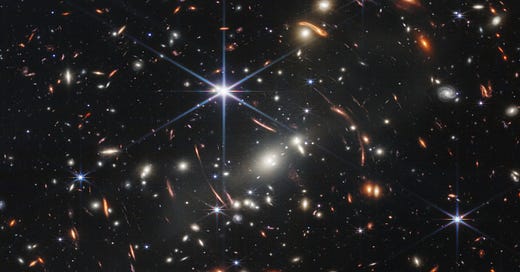The JWST Era Begins...
New image released today in anticipation of full release of first images tomorrow.
NASA moved up its release of the first JWST, probably to accommodate a request from the White House for something upbeat to report. Today, at 5 pm President Joe Biden and NASA Administrator Bill Nelson President released a single spectacular preview image, shown above, and described below. Tomorrow the full slate of first images will be released, representing the first wave of color scientific images as well as spectra the observatory has gathered, and this marks official beginning of Webb’s general science operations. The images selected by an international committee of representatives from NASA, ESA, CSA, and the Space Telescope Science Institute, include, as described by NASA on their web site:
Carina Nebula: The Carina Nebula is one of the largest and brightest nebulae in the sky, located approximately 7,600 light-years away in the southern constellation Carina. Nebulae are stellar nurseries where stars form. The Carina Nebula is home to many massive stars, several times larger than the Sun.
WASP-96 b (spectrum): WASP-96 b is a giant planet outside our solar system, composed mainly of gas. The planet, located nearly 1,150 light-years from Earth, orbits its star every 3.4 days. It has about half the mass of Jupiter, and its discovery was announced in 2014.
Southern Ring Nebula: The Southern Ring, or “Eight-Burst” nebula, is a planetary nebula – an expanding cloud of gas, surrounding a dying star. It is nearly half a light-year in diameter and is located approximately 2,000 light years away from Earth.
Stephan’s Quintet: About 290 million light-years away, Stephan’s Quintet is located in the constellation Pegasus. It is notable for being the first compact galaxy group ever discovered in 1877. Four of the five galaxies within the quintet are locked in a cosmic dance of repeated close encounters.
SMACS 0723: Massive foreground galaxy clusters magnify and distort the light of objects behind them, permitting a deep field view into both the extremely distant and intrinsically faint galaxy populations.
These images reflect different aspects of JWST’s mission. The beautiful color images of nearby objects are primarily artistic renderings that inspire, although of course greater detail will be obtained on these objects than ever before.
The spectrum of the WASP 96-b represents one of the two main mission aspects of JWST. Obtaining spectra from extrasolar planets will allow us to determine, among other things, the compositions of their atmosphere, eventually aiding the search for life elsewhere in the universe.
The SMACS 0723 object involves the use of gravitational lensing, where foreground objects can magnify images of more distant objects because of the bending of light by gravity. Since one of the purposes of JWST is to search for the oldest luminous objects in the universe, this technique will help the observatory push the limits of its resolution back, probably to the end of the ‘dark ages’ just before stars and galaxies began to form and shine.
The SMAC 0723 Image is the one shown at the White House, and represents the deepest image ever shown so far. It will undoubtedly hold that record for only a very short time. In this image many images of more distant galaxies are distorted and stretched more or less circularly around the center of mass of of the cluster of more nearby galaxies in the center of the image. That cluster is about 4.6 billion light years away
Stay tuned for more exciting images, and hopefully discoveries, in the months and years to come!






Couple of really cool James Webb first image media. First one is a tweet from Astronomy Prof. Alyssa Goodman from Harvard with a great video of the new image. The second one is a website with the tool Prof. Goodman uses in her video.
https://twitter.com/alyssaagoodman/status/1546675001755111424?s=21&t=hZv4y7sF65qD320l74Bvdg
https://web.wwtassets.org/specials/2022/jwst-smacs/
Yeah, this morning I see Joe Biden holding a press conference. Don't remember when the last POTUS personally held a press junket for science. I guess times are tough all over...